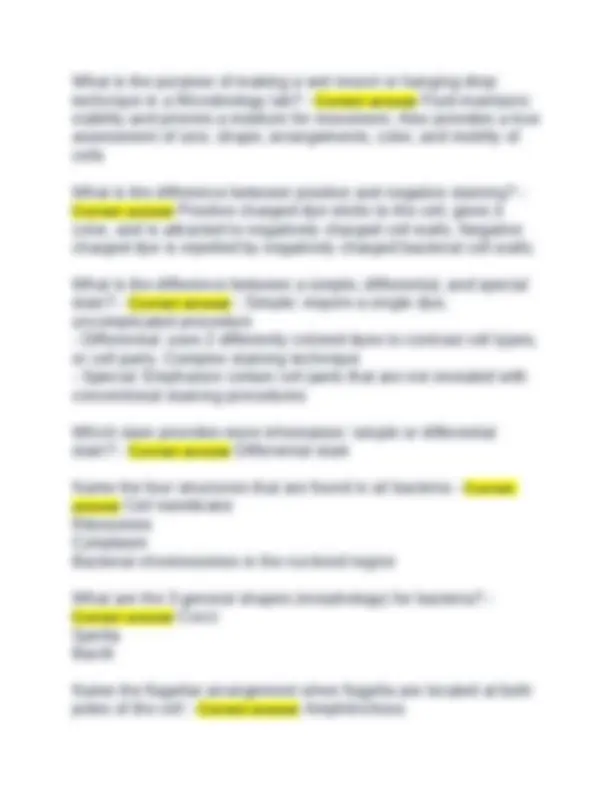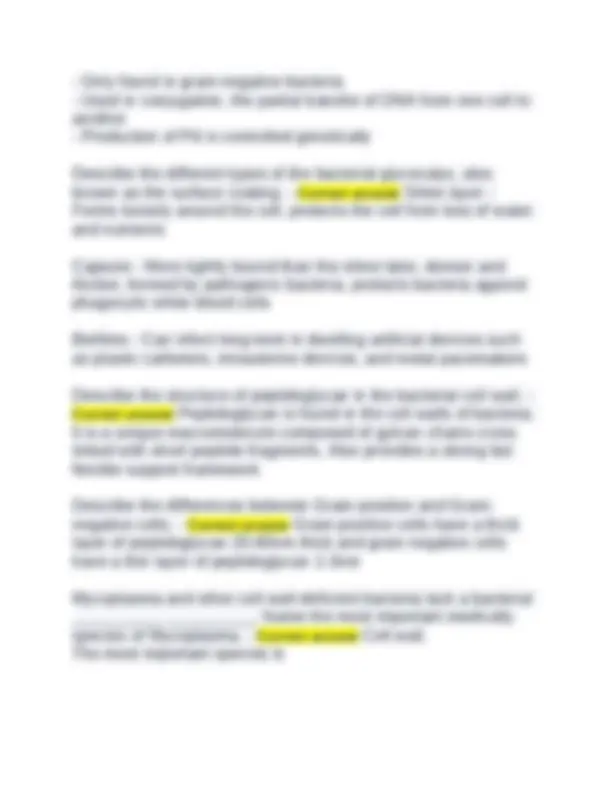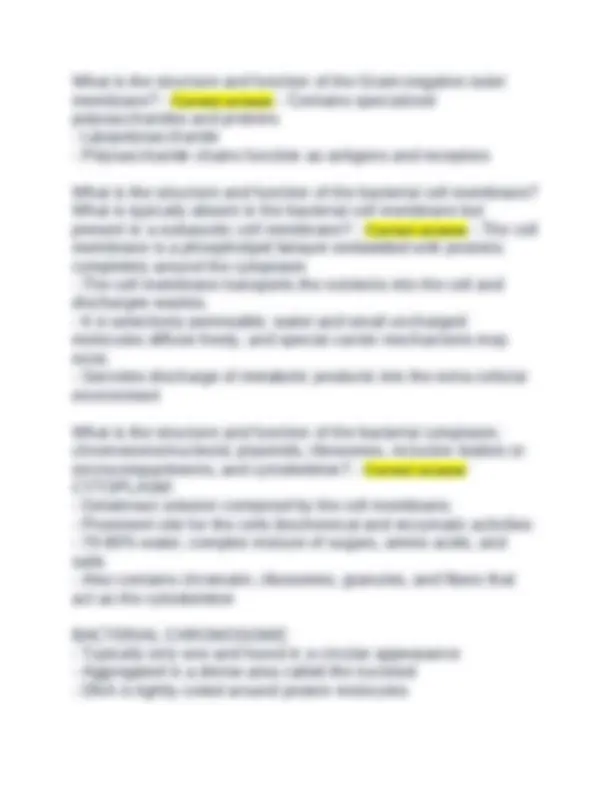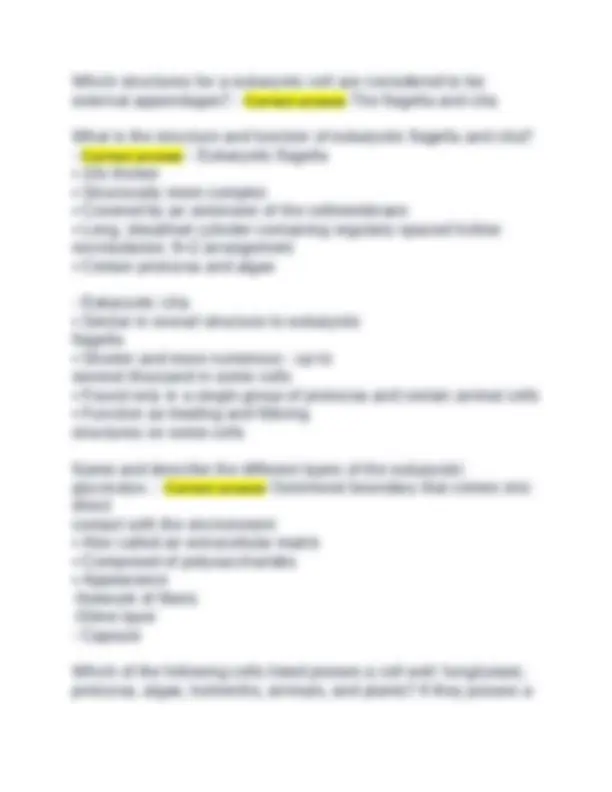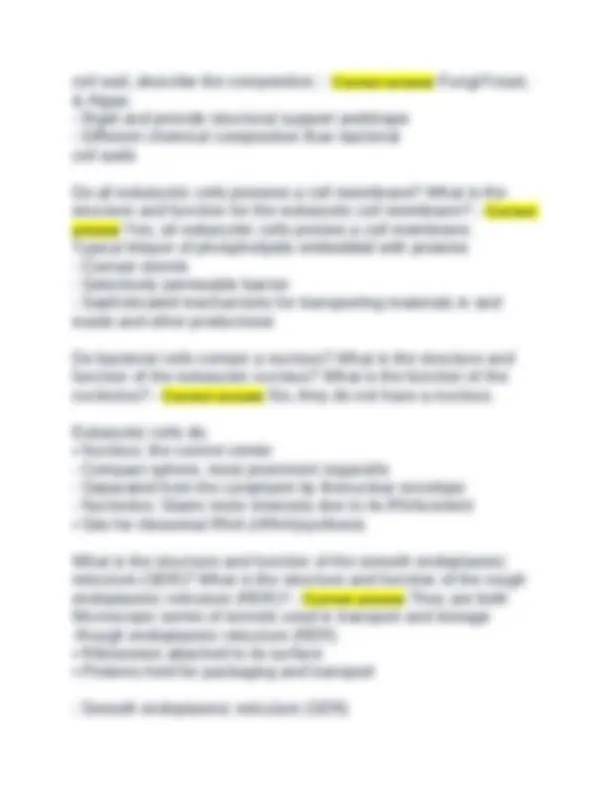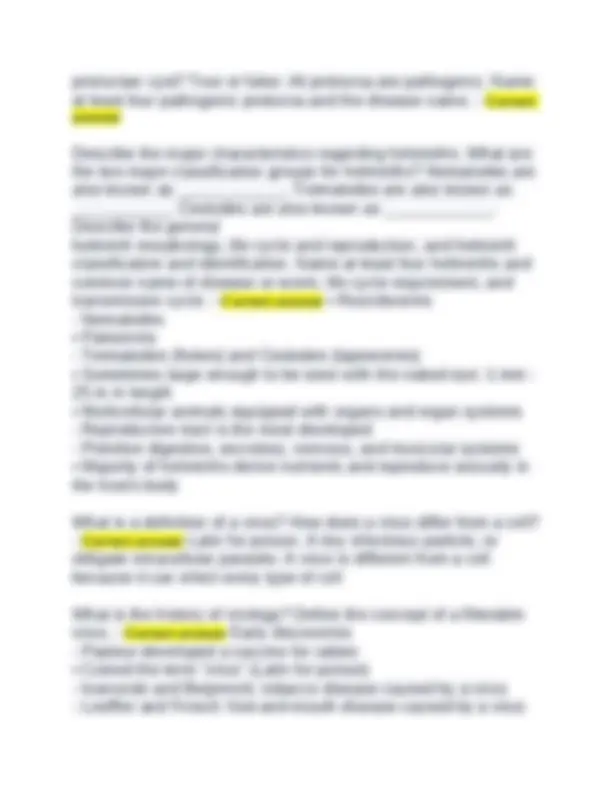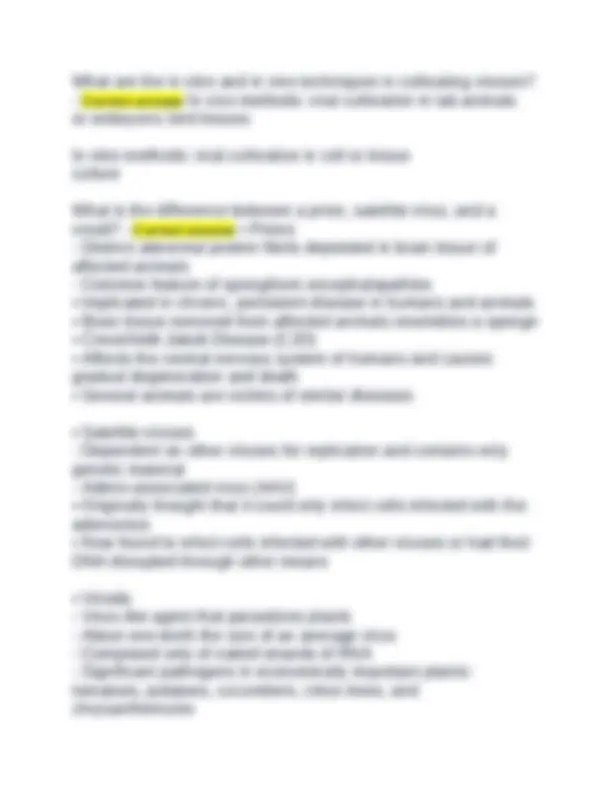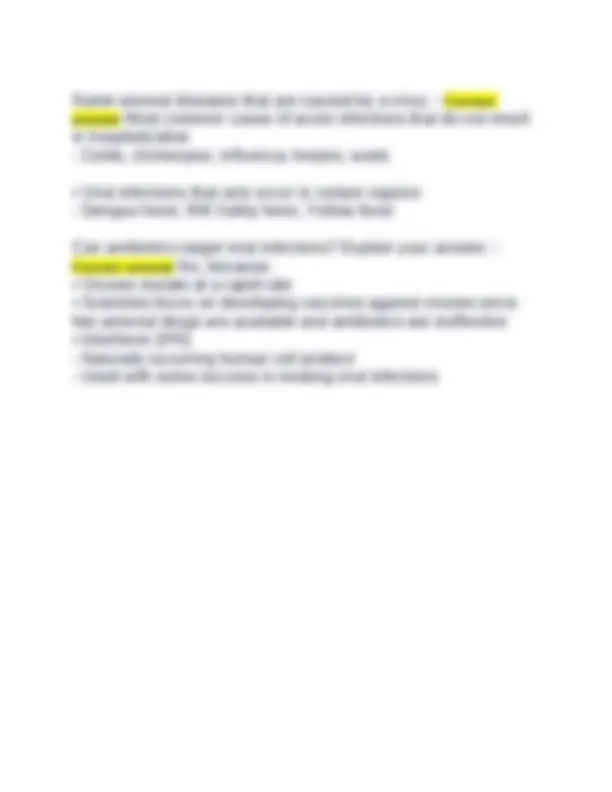Download Microbiology Exam 1 (Chapter 1,3,4,5,6) Questions and Answers. and more Exams Microbiology in PDF only on Docsity!
Microbiology Exam 1 (Chapter 1,3,4,5,6)
Questions and Answers.
Microbiology - Correct answer The specialized area of biology that deals with organisms too small to be seen with the naked eye 6 major groups of microorganisms - Correct answer 1. Bacteria
- Algae
- Protozoa
- Helminths
- Fungi
- Viruses What do microbiologists study? - Correct answer - Cell structure
- Growth and Physiology
- Genetics
- Taxonomy and evolutionary history
- Interactions with living and non living environment What are the 6 different branches of study in microbiology? - Correct answer 1. Medical microbiology
- Public Health microbiology and Epidemiology
- Immunology
- Industrial Microbiology
- Agricultural Microbiology
- Environmental Microbiology Medical Microbiology - Correct answer Study of microbes as they relate to medicine, deals with microbes that causes disease in humans and animals Public Health Microbiology and Epidemiology - Correct answer Monitor and control the spread of disease in communities. USPHS, CDC, WHO
Industrial Microbiology - Correct answer - Use of microbes to manufacture important compounds
- Safeguards our food and water
- Also includes biotechnology
- Ranges from bread making to gene therapy
- Microbes can be used to create large quantities of substances such as amino acids, beer, drugs, enzymes, and vitamins Agricultural Microbiology - Correct answer - Deals with the relationships between microbes and domesticated plants and animals
- Plant specialists focus on plant diseases, soil fertility, and nutritional interactions
- Animal specialists work with infectious diseases and other associations animals have with microorganisms Immunology - Correct answer Studies a diverse areas such as vaccination, blood testing, and allergy. Immunologists investigate the role of the immune system in cancer and autoimmune diseases Environmental Microbiology - Correct answer Studies the effect of microbes on the earth's diverse habitats. Example- aquatic microbiology, soil microbiology, geomicrobiology, and astrobiology eu-kary means? - Correct answer true nucleus; cells with a nucleus are classified as eukaryotes Pro-kary means? - Correct answer Pre-nucleus; bacteria and archaea do not have a nucleus and have been traditionally classified as prokaryotes What is a microbe? - Correct answer A microorganism
- Protists characterized by the absence of chlorophyll and by the presence of a rigid cell wall Medical Microbiology - Correct answer - Deals with diseases of humans and animals
- Study the way microorganisms cause disease
- Example: A Microbiologist at the CDC may examine a culture of the influenza virus in order to understand why is is so harmful Public Health Microbiology & Epidemiology - Correct answer - Monitor and control the spread of diseases in communities
- CDC, USPHS, & WHO
- Example: Epidemiologists conduct interviews as a part of the effort to curb the cholera epidemic in Haiti Immunology - Correct answer - Studies the web of protective substances and cells produced in response to infection
- Vaccination, blood testing, and allergy
- Immunologists investigate the role of the immune system in cancer and autoimmune diseases
- Example: Immunologists freeze dry samples of infectious diseases Industrial Microbiology - Correct answer - Branch of microbiology in which microbes are manipulated to manufacture useful products
- Ranges from bread making to gene therapy
- Safeguards our food and water
- Microbes can be used to create large quantities of substances such as amino acids, berm drugs, enzymes and vitamins
- Example: Scientists use a multispectural imaging systems for inspection of chickens to be manufactured
Agricultural Microbiology - Correct answer - Concerned with the relationship between microbes and domesticated plants and animals
- Plant specialists focus on plant diseases, soil fertility, and nutritional interactions
- Animal specialists focus on infectious diseases and other associations animals have with microorganisms Environmental Microbiology - Correct answer - Studies the effect of microbes on the Earth's diverse habitats
- 4 Types: Aquatic, Soil, Geo, and Astro
- Studies microbes in the earths surface water, soil, crust, and places off of our planet What type of cells originated first on planet Earth? What type of cells evolved next? What type of organism evolved last? - Correct answer Prokaryotic cells originated fist, followed by Eukaryotic cells, and lastly viruses Photosynthesis - Correct answer Light-fueled conversion of carbon dioxide to organic material, accompanied by the formation of oxygen What kind of organisms can proceed with photosynthesis? - Correct answer Bacteria and Algae What is decomposition? - Correct answer Breakdown of dead matter and wastes into simple compounds that can be recycled What type of organisms can proceed with decomposition? - Correct answer Bacteria and Fungi Genetic Engineering - Correct answer Manipulates the genetics of microbes, plants, and animals for the purpose of creating new products and genetically modified organisms (GMOs)
What type of cell does not have have membrane bound organelles nor a nucleus? - Correct answer Prokaryotic What type of microbe is not a cell? - Correct answer Virus What is Robert Hooke responsible for in Microbiology? - Correct answer The first observations of microbes What is Antoine van Leeuwenhoek responsible for in Microbiology? - Correct answer Invention of the microscope Describe the most recent scientific discoveries that have made an impact in the field of microbiology. - Correct answer 1970s: Discovery of restriction enzymes 1980s: Inventions of the PCR technique 2000s: Importance of small RNAs 2010s: Role of the human microbiome What is John Tyndall responsible for in Microbiology? - Correct answer Found that microbes in the dust and air have high heat resistance What is Ferdinand Cohn responsible for in Microbiology? - Correct answer - Discovered and described bacterial endospores
- Discovered Sterile, which is completely free of all life forms including endospores and virus particles What are Ignaz Semmelweis, Dr. Oliver Wendell Homes, and Joseph Lister known for in Microbiology? - Correct answer Dr. Oliver Wendell Holmes and Dr. Ignaz Semmelweis - Development of Aseptic techniques. Showed that women became infected in the maternity ward after examinations done by physicians who had been working in the autopsy rooms.
Joseph Lister - First to introduce aseptic technique and utilize hand washing and misting operating rooms with antimicrobial chemicals. These techniques are still used today What are Luis Pasteur and Robert Koch responsible for in Microbiology? - Correct answer Luis Pasteur - Contributed to the microbial fermentation role in wine and beer production, invented pasteurization, showed that human diseases could arise from infection Robert Koch - Established Koch's postulates, a series of proofs that verified the germ theory of disease, linked a specific microorganism with a specific disease (Anthrax- Bacillus anthracis). Also developed numerous lab techniques What is spontaneous generation? - Correct answer The theory that life appears from nonliving things Who is responsible for disproving spontaneous generation? - Correct answer Luis Pasteur Who verified the germ theory? - Correct answer Robert Koch Describe the steps in order for the Scientific Method - Correct answer 1. Make an observation - through experience, thoughts, or reading
- Conduct background research - learn more about what you have observed Make a hypothesis - form a question to be tested and answered
- Experiment - Test the question with an experiment
- Observe outcome - Observe what is seen from the experiment
- Analyze data and draw conclusions - Explain what was seen and whether or not the hypothesis was corrrect
- Develop a theory backed by research
Meningitis, Typhoid fever, Chagas' disease, Trichomoniasis, Tuberculosis, Toxoplasmosis, Lyme disease, Leptospirosis, SARS, Rotavirus, Onchocerciasis, Pertussis, African Sleeping Sickness, Leishmaniasis, Gonorrhea, & Ringworm - Correct answer Malaria - Protozoa Amoebic dysentery - Bacteria HIV/AIDS - Virus Schistosomiasis - Helminth Anthrax - Bacteria Red tide - Algae Yellow fever - Virus Catch-scratch disease - Bacteria Hepatitis - Virus Cholera - Bacteria Meningitis - Bacteria and Virus Typhoid fever - Bacteria Chagas' disease - Protozoa Trichomoniasis - Protozoa Tuberculosis - Bacteria Lyme disease - Bacteria Leptospirosis - Bacteria SARS - Virus Rotavirus - Virus Onchocerciasis - Helminth Pertussis - Bacteria African Sleeping Sickness - Protozoa Measles - Virus Leishmaniasis - Protozoa Gonorrhea - Bacteria Ringworm - Fungus The accumulation of changes that occurs in organisms as they adapt to their environments - Correct answer Evolution
Consist of prokaryotic cells and Staphylococcus aureus and Escherichia Coli are examples of this organism - Correct answer Bacteria What type of microbe is classified as a tiny infectious particle? - Correct answer Virus List the taxonomic categories in order from general to specific - Correct answer - Domain
- Kingdom
- Phylum
- Class
- Order
- Family
- Genus
- Species The purposeful addition of a specimen into/onto culture medium - Correct answer Inoculation A microscopic cluster of cells that originated from a single cell - Correct answer Colony What type of medium allows multiple types of microbes to grow but is designed to show visible color differences among those organisms? - Correct answer Differential What type of microscope uses visible light and produces well- defined, three-dimensional images? - Correct answer Compound microscope What type of dyes are used in positive staining and are attracted top the negatively charged cell? - Correct answer Basic
Identification - Correct answer - Microbial profiles are determined y phenotype testing, genotype testing, macroscopic and microscopic analysis What is media and how is culture medium used in a Microbiology lab? - Correct answer - Media is designed for growth of specimens
- Culture medium encourages the growth, support and survival of microorganisms Describe the 3 physical states of media and the purpose of each - Correct answer - Liquid: found in test tubes, termed broths, milks, infusions
- Semi-solid: clot like, found in test tubes, determines motility of bacteria
- Solid: provide a firm surface on which cells can form discrete colonies What are the characteristics of agar? How is agar used in a Microbiology lab? - Correct answer - extracted from red marine algae and solid at room temperature and liquifies at 100 degrees Celsius
- used to form a clot like consistencies in test tubes and Petri dishes, used as a solidifying agent What is the difference between synthetic and non synthetic media? Name and example of each - Correct answer Synthetic (defined) media has chemical compositions which are precisely chemically defined. They may contain at least one component that is not chemically definable, contains extracts of animals, and may contain ground-up cells, tissues, or secretions. Non What are the differences between general purpose, enriched, selective, and differential media? - Correct answer - General purpose media groups a broad spectrum of bacteria and support a wide variety of microbial life.
- Enriched media contains complex organic substances that fastidious bacteria require for growth and contain growth factors such as specific vitamins or amino acids
- Selective media allows only one type of organism to grow
- Differential media allows multiple types of organisms to grow, but shows different reactions (ex. Change of color) Can a medium be classified as both selective and differential? - Correct answer Yes, some media can be both selective and differential Reducing medium - Correct answer Grows anaerobic bacteria What is the difference between a cell and a colony? - Correct answer - A cell us a unit of a colony
- A colony has millions of cells
- A colony can be even by the naked eye, but a cell needs a microscope Is a cell considered to be microscopic or macroscopic? - Correct answer Microscopic Is a colony considered to be microscopic or macroscopic? - Correct answer Macroscopic Transport media - Correct answer Maintains and preserves specimens Assay media - Correct answer Used to test the effectiveness of antimicrobial drugs Enumeration media - Correct answer Used in industrial and environmental microbiology
- Genotypic testing detects Microbes based on their DNA
- Immunologic testing tests the isolate against known antibodies Where are cultures disposed of after you are done with them? - Correct answer Stream sterilization (autoclaving) or incineration are used to destroy microorganisms A microscope has a total magnification of 850x when using the oil immersion objective lens. What is the power of the ocular lens? - Correct answer 8500 Magnification - Correct answer Total magnification = power of ocular lens x power of objective lens Resolution - Correct answer Distinguishes or separates two adjacent objects or points from one another Contrast - Correct answer Degree of contrast from the surroundings. Iris diaphragm controls the amount of light entering the condenser What is the difference between using the virtual and real image when using a microscope? - Correct answer The objective lens forms the initial image of the specimen which is the real image. The virtual image occurs when the initial image is projected up through the microscope body to the plane of the eyepiece to the ocular lens How does wavelength affect resolution? Why do you need to use oil when using the oil immersion lens? - Correct answer Longer wavelengths of light offer less resolution than short wavelengths. Oil prevents the scattering of light rays and increases the numerical aperture and resolution
Name the microscopes that use visible light for illumination - Correct answer Bright-field, Dark-field, Phase contrast, and Differential interference microscopes use visible light Name the microscopes that use UV rays for illumination - Correct answer Fluorescence and Confocal microscopes What is the difference between a light and electron microscope? - Correct answer An electron microscope uses beams of electrons instead of rays of visible lights like light microscopes do What type of microscope has the greatest total magnification? - Correct answer Scanning tunneling microscope ( 100,000,000x) When would a phase contrast, differential interference, or confocal microscope be useful in a microbiology lab? Name and describe the microscope we use in a microbiology lab. - Correct answer Phase contrast: most useful for observing intracellular structures such as bacterial spores, granules, and organelles, as well as locomotor structures of Eukaryotic cells such as cilia Differential interference: detailed view of unstained, live specimens by manipulating the light. Also adds contrasting colors rot the image and two beams of light rather than a single one Confocal: delivers sharper image focusing on just a single plane. Captures highly focused view at any level, ranging from the surface to the middle of the cell We use a Bright field microscope which produces an image brightly illuminated. Used for both live, unstained material, and preserved stained material
_______ _________ cells contain two layers in their cell envelope
- Correct answer Gram positive _______ ______ cells have an outer membrane made up of lipopolysaccharide (LPS) - Correct answer Gram negative What us the total size for a bacterial ribosome? - Correct answer 70S Clostridium, Bacillus, and Sporosarcina produce dormant highly resistant __________ - Correct answer Endospores Unique prokaryotic cells that are more closely related to Domain Eukarya than to Domain Bacteria - Correct answer Archaea Bergey's manual of ______________________ _______________________ is based on phenotypic characteristics and is used in clinical, teaching, and research labs
- Correct answer Determinative Bacteriology What is the structure and function of a bacterial flagellum? Describe the three parts of the bacterial flagellum. - Correct answer Composed of proteins. Three parts:
- Basal Body: a stack of rings firmly anchored through the cell wall to the body
- Hook: anchored to the cell by the basal body
- Filament: helical structure, composed of proteins, approximately 20 nanometers in diameter. Inserted into a curved, tubular hook
Describe the different arrangements for bacterial flagella. - Correct answer - Monotrichous polar: single flagellum
- Lophotrichous polar: several tufts emerging from same site
- Amphitrichous polar: flagella at both ends
- Petritichous: flagella randomly dispersed over the entire surface of the cell What is chemotaxis? What is the difference between positive and negative chemotaxis? - Correct answer Movement in response to chemical signals. Positive: Run - counterclockwise movement of the flagella, cells swim in a smooth, linear direction toward a stimulus Negative: Tumble - flagella reverses direction, causing the cell to stop What is the structure and function of axial filaments, also known as periplasmic flagella? - Correct answer - Two or more long coiled threads found in spirochetes
- Internal flagellum enclosed between the cell wall and cell membrane
- Impart twisting or flexing motion to the cell What is the structure and function of bacterial fimbriae? - Correct answer - Small bristle-like fibers sprouting off the surface of certain species of bacteria
- Composition varies, but most contain protein
- Have the inherent tendency to stick to each other and to surfaces
- E. Coli and the gonococcus use fimbriae to adhere to epithelial cells What is the structure and function of bacterial pili? - Correct answer - Also known as sex pious
- Long, rigid tubular structure made of pilin protein










